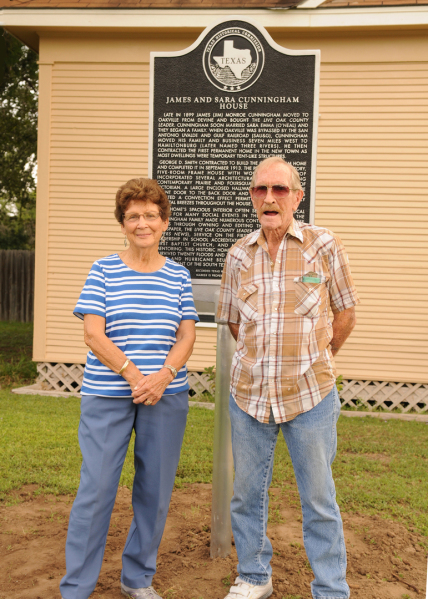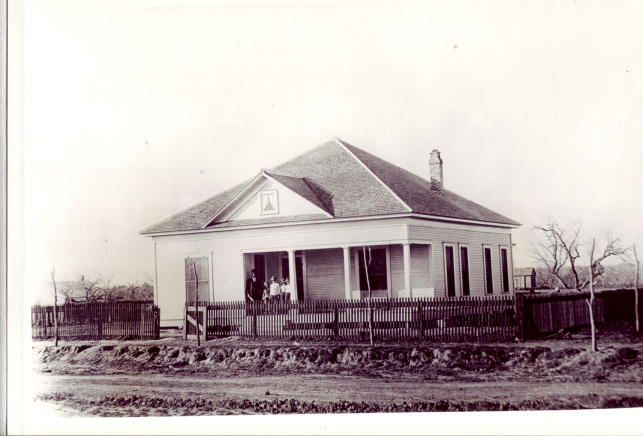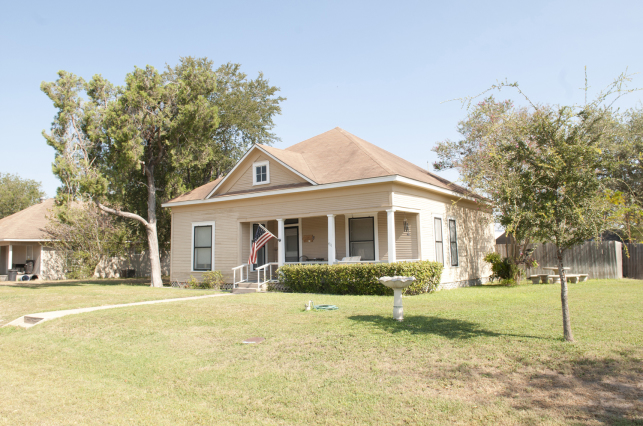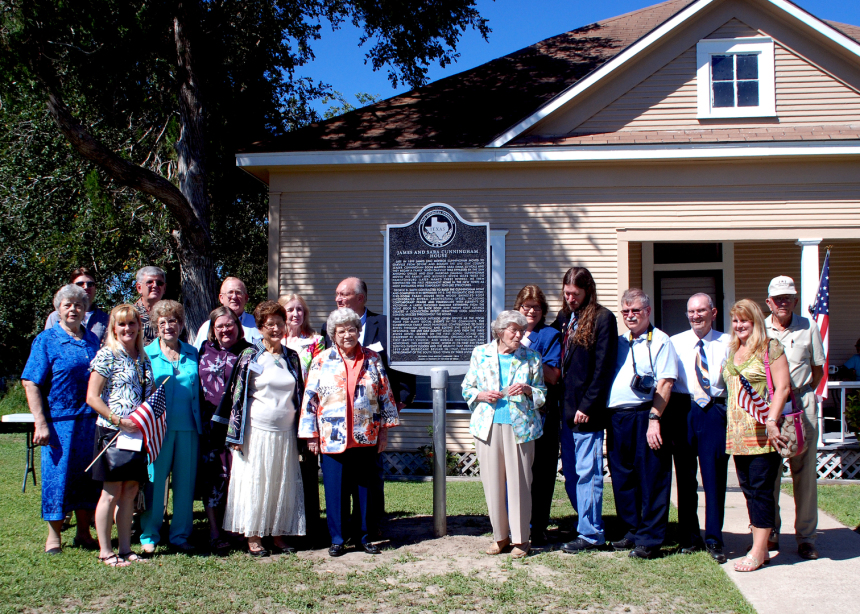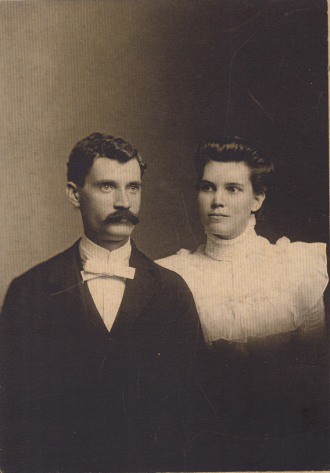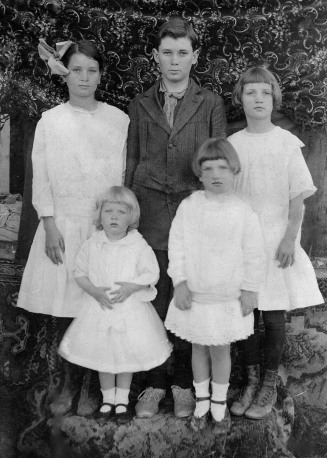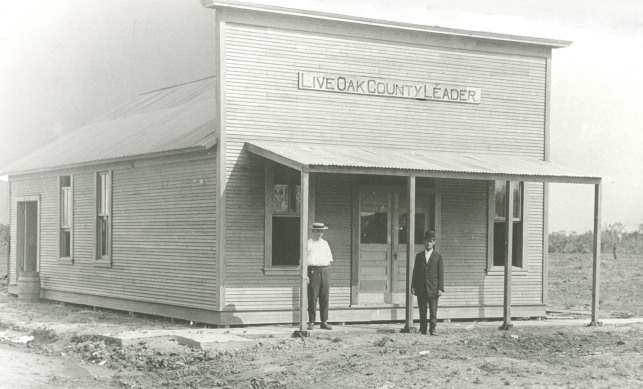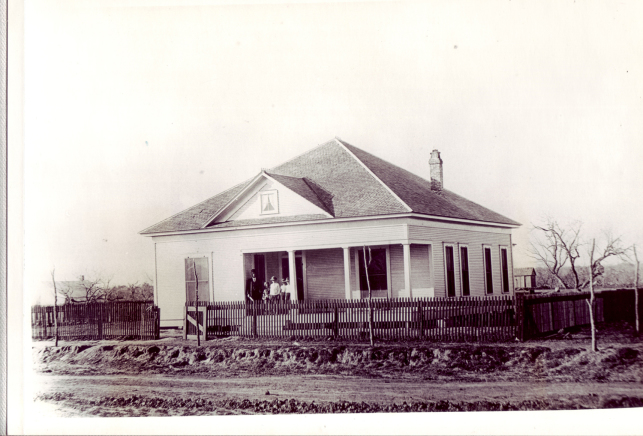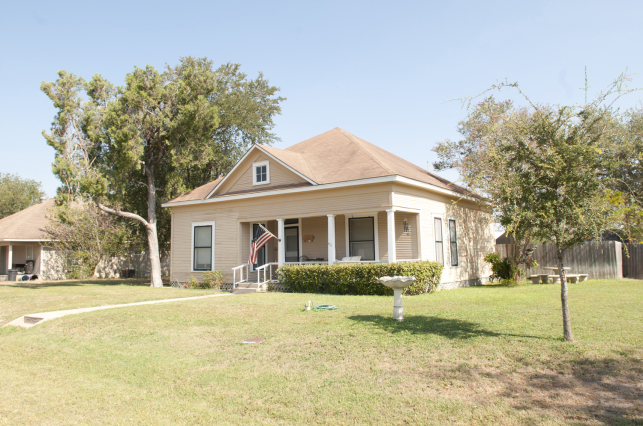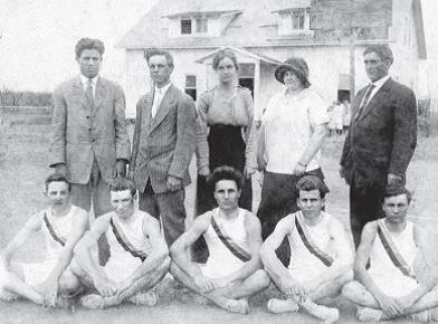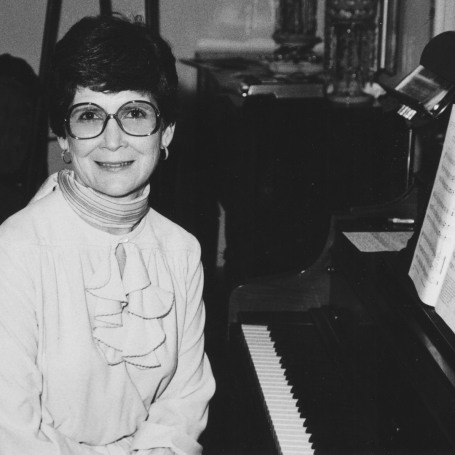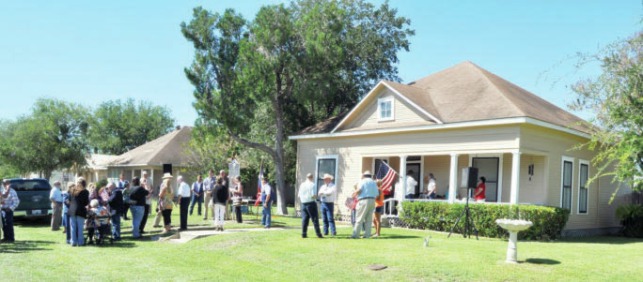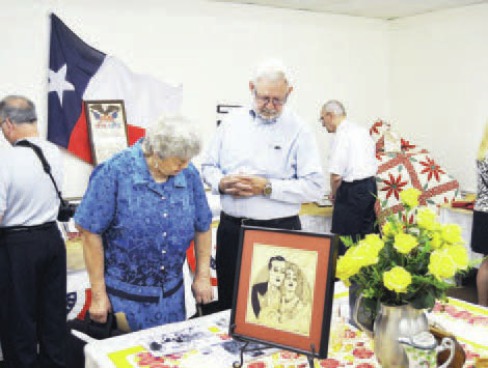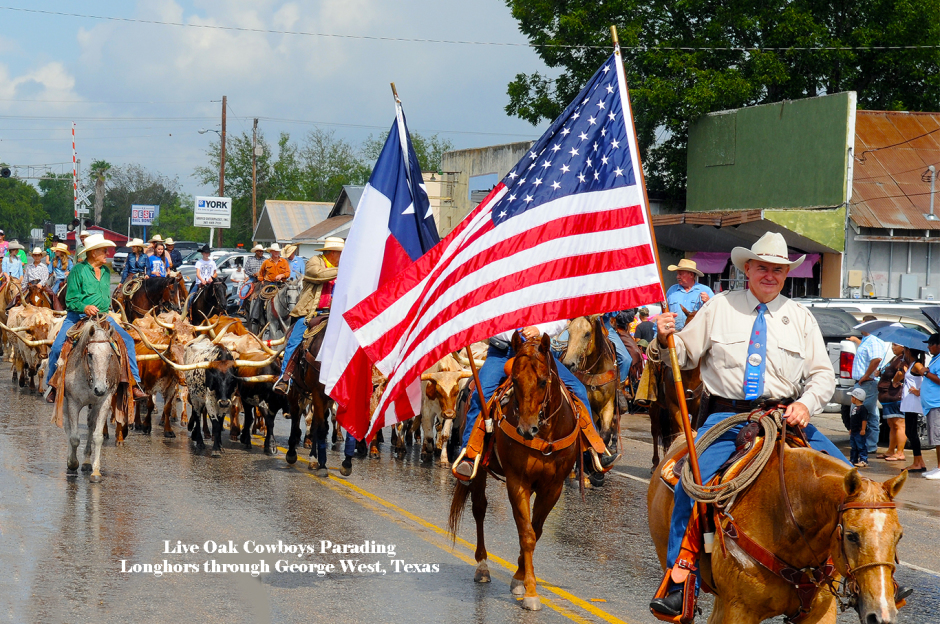
James and Sara Cunningham House
James and Sara Cunningham Home, first home built in Three Rivers, Texas, 1913. James stands on the porch with four children. Fence kept cattle and most wild animals away from the house. However, snakes paid no attention. Open gates meant even stray cows might invade the yard. Photo courtesy Betty Dickinson.
Descendants of James and Sara Cunningham stand with Betty Dickinson, marker sponsor, in front of the first house built in Three Rivers, Texas in 1913. The house was built by their forbear, James Cunningham, and maintained through the years by such propriertors as Sam Garcia, current Three Rivers Mayor, and present owner, Billy Johnson. Photo courtesy Jerry Hudson.
Live Oak County Judge: Honorable Jim Huff
Live Oak County Historical Commission Chair: Sue Denniston
LOCHC Marker Chair: Richard Hudson
Chair Assistant: Janis Hudson
Cunningham Marker Sponsor: Betty Dickinson
Date Unveiled: 2013
Contact: raven@historyraven.com
Cunningham Recorded Texas Historic Landmark Text:
James and Sara Cunningham House
Late in 1899 James (Jim) Monroe Cunningham moved to Oakville from Devine and bought The Live Oak County Leader. Cunningham soon married Sara Emma (O'Neal) and they began a family. When Oakville was bypassed by the San Antonio Uvalde and Gulf Railroad (SAU&G), Cunningham moved his family and business seven miles west to Hamiltonburg (later named Three Rivers). He then contracted the first permanent home in the new town as most dwellings were temporary tent-like structures.
George D. Smith contracted to build the Cunningham Home and completed it in September 1913. The pragmatic one-story, five-room frame house with wood shingled roof incorporated several architectural styles, including contemporary Prairie and Foursquare with elements of Victorian. A large enclosed hallway extending from the front door to the back door and twelve foot ceilings created a convection effect permitting cool southerly coastal breezes throughout the house. The home's spacious interior often served as the focal point for many social events in the community.
The Cunningham family made numerous contributions to Three Rivers through owning and editing the area's weekly newspaper, The Live Oak County Leader (and then The Three Rivers News), service on the first school board and leadership in school accreditation, organization of the First Baptist Church, and musical instruction and mentoring. This historic home, which in its first 100 years survived twenty floods and The Atlantic Gulf Hurricane of 1919 and Hurricane Beulah in 1967, embodies the development of the South Texas town of Three Rivers. (2013) Marker is the property of the State of Texas.
APPLICATION NARRATIVE and BIBLIOGRAPHY FOR OFFICIAL TEXAS HISTORICAL MARKER
JAMES AND SARA CUNNINGHAM HOUSE
I. CONTEXT
The James and Sara Cunningham House is located at 411 East Thornton Street in Three Rivers, Texas where it was originally built in 1913. Historically the first permanent home in Three Rivers, the town and the house celebrate their centennial in 2013. The well preserved, original exterior of the Cunningham home exemplifies the pragmatic style and materials used during the earliest development of Three Rivers and this region of South Texas. Besides being the owner and publisher of the local paper, the J. M. Cunningham family who owned and occupied the home for sixty plus years made significant contributions to the community in the areas of education, religious development, and appreciation of the arts, especially music and music education.[1]
Three Rivers was birthed on July 4, 1913 by Charles R. Tips seeking his own dream of becoming a “colonizer” like the empresarios “who settled at least one hundred families” on contracted grants of land in Texas during Spanish and Mexican rule.[2] The town drew first generation immigrants from European countries such as Germany, Ireland, France, and England, as well as Mexico. Second and third generation Americans looking for a new beginning also made it their home. Three Rivers, first called Hamiltonburg for the original landowners, is located at the confluence of the Atascosa, Frio, and Nueces rivers and at the intersection of State Highway 72 and U.S. Highway 281, halfway between San Antonio and Corpus Christi in north central Live Oak County.[3]
Prior to 1836, Live Oak County constituted the northern part of the McMullen-McGloin (San Patricio) Colony belonging to Mexico. When Texas won its independence from Mexico, Live Oak County was still part of San Patricio County. Because of depredations by Indian, Mexican, and North American desperadoes, leaders of this northern section of San Patricio petitioned the state legislature in 1855 to create the county of Live Oak. It became an established Texas county on February 2, 1856. Oakville, a thriving crossroads community, was chosen as the county seat.[4]
Late in 1899 James (Jim) Monroe Cunningham came from Devine, Texas to Oakville and bought the Live Oak County Leader.[5] Cunningham soon married, and his new bride, Sara Emma (O’Neal) joined him in Oakville. They began a family and worked together on the paper. When Oakville was bypassed by the railroad, Cunningham moved his business just about seven miles west to Hamiltonburg (later Three Rivers), Texas. He then contracted the first permanent home built in the new town.[6] For the past one hundred years the modest Cunningham house has been well maintained and moderately adapted with standard conveniences while preserving original features and simple architectural integrity which reflect enduring versatility from its origin until today.
II. OVERVIEW
In 1913, Oakville was a bustling hub with stage coaches and trade routes running south from San Antonio then east to Corpus Christi and from Goliad west to Laredo. Yet the new San Antonio Uvalde and Gulf Railroad (SAU&G) took a more westerly route and completely bypassed it. Cunningham predicted the town would die. Having seized upon the advantageous proximity of a railroad and three converging rivers for his new town, Tips realized the need for a newspaper to keep citizens informed regarding local and world affairs. He offered Cunningham fifty dollars a month for five years if he would move his paper to the new town. Accepting Tips’ offer, he moved the newspaper office and contracted the first permanent home built in Three Rivers. Jim and Sara (called Emma) with their five Cunningham children prepared meals over an open fire day after day as their new home was built. One more child was born in Three Rivers, but died of influenza before he was three.[7]
While permanent business establishments were built along the intersection of Thornton and Harborth streets, the earliest homes in Hamiltonburg were temporary. Transitory workers and newcomers built tent-like structures with wooden floors and sides to deter the entrance of rattle snakes, rodents, and other small vermin. Twelve-year-old Cecil Cunningham with rifle in hand rode a donkey ready to shoot snakes and other undesirable varmints routed from their habitat by monstrous steam tractors clearing cactus and mesquite to make way for the townsite.[8] To complete the make-shift domiciles, wooden frames with screen doors and wide screened wraparounds above half walls allowed breezes to flow in throughout the day and after bedtime. Canvases lowered to the bottom of the screens protected a family’s privacy or kept rain and dust storms out. Canvas also furnished the rooftops of these temporary tent-like homes.[9]
George D. Smith contracted to build the Cunningham house. Completed in September, 1913, the home’s exterior is also seen in earlier photographs. Smith became a lifetime friend of the family even after moving to Austin. Along with the Cunningham family, George and his wife were charter members of the town’s first church, the First Baptist Church of Three Rivers. George’s attention to detail, sturdy construction, and structural integrity kept the house he built for the Cunningham’s strong and stable. Through its first 100 years, it survived twenty floods and a number of hurricanes including the Atlantic Gulf Hurricane of 1919 and Hurricane Beulah in 1967.[10] Mayor Jack Nance had a levee built around Three Rivers in 1982 which has protected the town from floods since that time.[11]
The Cunningham’s five room frame house painted light cream with a wood shingle roof set an affordable, yet attractive standard for the new town of Hamiltonburg.[12] Unlike antebellum Colonial homes, ornamental Victorians, or ornate Spanish homes built before the twentieth century, Jim and Emma chose a pragmatic one-story mixed style house. Its eclectic style incorporated a large enclosed hallway extending from the front door to the back similar to earlier pioneer homes with wide open dog trots. Horizontal lines and carefully grouped windows reflected those seen in contemporary Prairie and Four Square homes of the time. Twelve foot ceilings often found in older Victorian homes completed a pleasant and useful residence.
This efficient plan created a convection effect permitting cool southerly coastal breezes throughout the house from early spring to late October. The boxed rectangular exterior shelters spacious interior rooms which often served as the focal point for many social events in the community. From the front, a porch and single gable face south toward Thornton Street, while the horizontal length of the house runs east and west beside North Hermann Avenue, just a few blocks away from the school campus.
The original style and materials of the home are still present while a small number of changes have sustained the Cunningham house since it was built in 1913. The original simply carved wooden front door, with its top half supporting a glass window and glass transom above, still opens into the large beaded wood hallway today. Beaded wood ceilings are also retained throughout the house including the front porch. Some rooms still have original lighting, even though air conditioning was added by the current owner, Billy Johnson, who placed the unit in a closet made at the back of the house.[13] Hardwood floors above a pier and beam foundation also ensured coolness.
Replacement of these began when termites were discovered during the Garcia’s ownership, and this work was completed by Johnson. When modern plumbing became available, a water heater and kitchen sink were added along with a bathroom at the back. The original flue for the first kitchen’s wood stove is still an obvious part of the house.[14] Sara Emma lived in the home until her death in June of 1938. Jim remained there until his death on October 16, 1948, just months before his fiftieth anniversary as the paper’s editor.[15] Their daughter, Gladys, continued living in the home until her passing on January 30, 1995.[16] She willed the property to her relatives, Nancy Cunningham and Margaret Custer, who later sold it. Subsequent owners of the James and Sara Cunningham House include: Princess Betty Jean Lord, Samuel and Kathy Garcia, and Billy Ray Johnson who currently lives in the home.[17]
The Cunningham family began contributions to Hamiltonburg in 1913, and they continue today. By late summer of 1913 the move of the newspaper office was completed, and the weekly edition of the Live Oak Leader extolled the many benefits of living in Hamiltonburg; the social column welcomed new residents. Printed court notices, voting ballots, funeral notices, wedding announcements, letterheads and envelopes are just samplings of services offered. When the town changed its name from Hamiltonburg to Three Rivers in 1914, the paper became The Three Rivers News to better represent the town.[18] Cecil, the eldest son began working at the newspaper when in high school and continued after his father’s death and finally retired in 1970.[19] After Cecil’s retirement, The Three Rivers News merged with the Live Oak Herald to become The Progress of Live Oak and McMullen Counties.[20]
Education was foremost to Charles Tips and Jim and Emma Cunningham. When the school bell rang at the newly built one-room yellow school house on the first day of school in 1913, three Cunningham children were present. Four generations of Cunningham children continued through the halls of the Three Rivers schools.[21] Jim Cunningham served as one of three members on the first school board chaired by Tips. With informative assistance from the Leader, the town voted at the end of the year to establish an eleven grade Independent School District with a principal and six teachers.
The new school was built on ten acres donated by Tips’ father, Charles E. Tips, at the east end of Thornton Street running parallel with School Road and in easy walking distance from the Cunningham’s. Twenty-five students graduated at the end of that second year [Spring 1915], and the school was recognized by the state as a “high school of the first class.”[22] Because of inclement weather, impassable unpaved roads, and the lack of busing during the early days, some rural students in the Three Rivers Schools stayed with families in town until the dry season began. The Cunningham’s were among those that opened their doors allowing numerous students to continue their education without interruption.[23]
In the early days, the Cunningham home was a landmark social center. 1913 photographs of Tip’s land sale events show the roof line of Cunningham’s house at the far end of Thornton Street where horsemen began their race west to the finish line held by Jim Cunningham and Willie McMurray.[24] Music rounded out the family’s interests and talents. The musical tradition begun by Jim and Emma for family and community has been handed down through generations. Jim played the piano, organ, and also sang. Emma taught piano and voice; daughter, Gladys, taught piano, guitar, and voice for more than fifty years in their home studio. She was honored in 1984 by the First Baptist Church and Little Acorn Study Club of Three Rivers and again by the Methodist Church in 1988 when internationally acclaimed concert pianist Richard Urbis was invited to perform in Three Rivers. This love of music was carried forward by granddaughter, Betty Reynolds Dickinson, whose early study of piano began in the Cunningham home with Miss Gladys. Betty taught music for 33 years and gave many concert piano performances. Churches, schools, and community organizations have benefitted from music students trained in studios of the Cunningham ladies. [25]
The Reverend J. W. Cunningham, Jim’s father, presided over the organization of the First Baptist Church, the first church in the new town, on Sunday, November 9, 1913. Jim and Emma were active charter members, faithful until their deaths. Jim served as deacon, song leader, and Sunday School Superintendent, providing religious education for the members of the church.[26] Cunningham descendants are among the many faithful today. Jim and Sara Cunningham’s home was continually open to the clergy and others who came from out of town to serve whether for a week or just to enjoy a meal.
III. SIGNIFICANCE
The James and Sara Cunningham House is the first permanent family home built in Three Rivers, Texas. The house with simple, mixed characteristics of Pioneer, Prairie, and utilitarian Victorian aspects demonstrates the eclectic dynamic that grew a culture of immigrants into a lasting farming and ranching community. The lack of austerity and grandeur coupled with the contributions of the family who made this house their home illustrate how an almost classless community grew from the beginning of the century until now. The Cunningham family contributed greatly to the growth and education of Three Rivers. James Monroe Cunningham and then his son owned and managed the Three Rivers’ paper from the town’s birth for fifty-seven years. Mr. Cunningham served on the first school board while Cunningham children attended Three Rivers Schools for four generations. Sara Emma Cunningham; her daughter, Gladys Cunningham; and Emma’s granddaughter, Betty Reynolds Dickinson, taught music to children of the town and throughout South Texas for more than ninety years producing several concert pianists. The Cunningham’s were charter members of the First Baptist Church, and their descendants continue to serve there. Numerous members of the family have served in America’s armed forces. Minor modernization has changed the house little, and it is as sturdy today as when it was built a hundred years ago. This significant first residence symbolizes the pragmatic development of the South Texas town of Three Rivers at the beginning of the twentieth century true to its environment and culture. It would be honored by receiving a Texas State Historical Marker during its hundredth year.
VI. DOCUMENTATION
[1] Charles Tips, letter to Cecil Cunningham, November 1, 1948, Author’s collection; Betty Reynolds Dickinson, email message to Richard Hudson, September 13, 2012, Author’s collection.
[2] Tips, Charles, “The History of the Founding of Three Rivers, Texas” (Unpublished personal paper, 1963. 2. Author’s Collection.
[3] V. Sue Nance, "THREE RIVERS, TX," Handbook of Texas Online, accessed September 17, 2012, http://www.tshaonline.org/handbook/online/articles/hjt05. Published by the Texas State Historical Association.
[4] Sparkman, Ervin. The People’s History of Live Oak County, Texas. Mesquite: Ide House, 1981. 1-39. Book available in the Three Rivers and George West libries.
[5] James Monroe Cunningham, handwritten letter to fiancée, Miss Sara Emma O’Neal, December 4, 1899. Author’s collection.
[6] Cunningham, Cecil and Gladys. The History of the People of Live Oak County, Texas: “J.M. Cunningham.” George West: Live Oak County Historical Commission, 1982. 98. George West library.
[7] Ibid.
[8] Hudson, R.E. “Early Scenes in Hamiltonburg (Three Rivers) 1918-1914.” The Portals to Texas History. accessed September 24, 2012. http://texashistory.unt.edu/ark:/67531/metapth139750/?q=Three%20Rivers, Published by the University of North Texas.
[9] Ibid.
[10] Cunningham, Cecil. “Cecil Cunningham.” The History of the People of Live Oak County, Texas. George West: Live Oak County Historical Commission, 1982. 7.
[11] Adlof, Viola. “Three Rivers.” The History of the People of Live Oak County, Texas. George West: Live Oak County Historical Commission, 1982. 23-24.
[12] Hudson. Ibid.
[13] Tax records: Live Oak County Appraisal District, George West. Author’s collection.
[14] Hudson, Richard. Current photographs of Cunningham home taken on September 3, 2012.
[15] Obituary, “James Monroe Cunningham,” Three Rivers News, October 28, 1948.
[16] Obituary, “Gladys Cunningham,” Three Rivers News, February 1, 1995.
[17] Deeds records: V. 10, p. 14; Vol. 69, p. 84; Vol. 41, p. 346; Vol. 41, p. 347; Vol. 529, pp. 445-448; Vol. 605, pp. 280-281; Vol. 13, pp. 442-444. Office of the Live Oak County Clerk, Live Oak County Courthouse, George West.
[18] Reynolds Dickinson. 2.
[19] Cunningham, Cecil, “Cecil Cunningham.” The History of the People of Live Oak County, Texas: George West: Live Oak County Historical Commission, 1981. 97.
[20] Sparkman. 146.
[21] Ibid.
[22] Tips, Charles. 40-42.
[23] Reynolds Dickinson.
[24] Hudson.
[25] Reynolds Dickinson.
[26]Author unknown. “First Baptist Church History, Three Rivers, Texas.” 2003. 1-2.
Our Yesterdays: The Cunninghams, Three Rivers first house and newspaper
James and Emma (O'Neal) Cunningham married July 4, 1900. Exactly 13 years later, Charles R. Tips officially celebrated the founding of Hamiltonburg, later named Three Rivers. On July 4, 1913, as part of the festivities, horses and riders lined up in front of the partially-constructed Cunningham house and raced up Thornton Ave. to the finish line at Harborth, today U.S. Highway 281. Photo courtesy Cunningham family.
The Live Oak and McMullen County Progress
Page 2 A Aug. 21, 2013
By Richard and Janis Hudson
Special to The Progress
The turn of the 20th century opened new horizons for James “Jim” Monroe Cunningham. Jim was the eldest son of J.W. and Sara Malissa (Elliot) Cunningham, early Baptist
missionaries who moved from Tennessee to Texas in 1884 when Jim was 14 years old. An accomplished musician even at that age, Jim played the piano and organ and sang in his father’s
services.
In the 1890s, when Jim was between 18-22, he began working for the Devine News. There he developed a love for the newspaper business and the written word. During
this time, Jim saved money and began calling on Miss Sara Emma O’Neal. By 1899 at the age of 27, he wanted a newspaper of his own.
When the Oakville County Leader came up for sale, Jim bought the paper and moved to Oakville, the county seat of Live Oak County.
His letters to Emma told how much he missed her and how energizing life as a newspaper editor in Oakville was for him. He spoke most admirably of his mentor and friend,
Judge Frank Church, from whom he purchased the newspaper. By July 4, 1900, Jim returned to Devine to marry Emma.
In Oakville, Jim and Emma worked together to print the newspaper. He taught Emma the tedious job of placing letters into a type form one at a time. He placed the form on a George Washington Hand Press and inked the letters with a hand roller. Placing a large sheet of paper over the forms, Jim pulled a lever, and the newspaper was printed. On a good day, Jim printed about 200 papers in an hour.
Jim and Emma began a family in Oakville with the birth of Cecil Floyd born Feb. 25, 1902. Then Mary Eunice, called “Maggie” by the family, was born Oct. 22, 1903, in
Devine, followed by Susie Pauline, born in Oakville on Oct. 27, 1905.
Expanding his horizons, Jim put his brother, Elliott, in charge of The Oakville County Leader in 1910, and purchased half-interest in the Kenedy Advance with Dan Chestnut. Jim moved his family to Kenedy where Gladys Idell was born on Jan. 10, 1911, followed by James Marvin on March 3, 1913. When Chestnut married and offered Jim the chance to buy him out or sell his part to Chestnut, Jim sold.
In that same year when the railroad bypassed Oakville creating the new town of Hamiltonburg seven miles west, Jim predicted Oakville would die. He contacted Charles Tips, founder of the new town, who offered Jim $50 a month for five years to move his paper to Hamiltonburg, later renamed Three Rivers.
Jim first built a newspaper plant and moved his family into the back of the building. Meals were cooked out back on an open campfire. For bad weather, Jim built a lean-to
attached to the back of the building where they cooked their meals.
One night, Emma awoke to loud claps of thunder and a down-pour. She peeked out the side window. Alarmed, she quickly awoke everyone saying they must leave because the water was already up to the clothes-line. Jim checked and teasingly suggested they stay put because the clothesline was actually “down to the water.” The family lived in the newspaper plant until George Smith, with whom Jim contracted, finished building their permanent home, the town’s first.
James and Emma (O'Neal) had six children: (back row from left) Mary Eunice, Cecil Floyd (the eldest), Susie Pauline; James Marvin and Gladys Idell. Not shown is the last child, Clyde Neal who died when 2 1/2 years old from influenza during the epidemic of 1918-19. Clyde's short life was always remembered fondly by the family. Photo courtesy Cunningham Family.
On July 4, 1913, Tips grand opening sale was also Jim and Emma’s 13th anniversary. Horse races began that day on Thornton Street in front of their unfinished house. The horses raced almost to Harborth where Jim and Willie McMurray held the finish line taut. As a notary public, Jim carried a small white table into the rough, scrabbled fields freshly divided into lots. There he legalized contracts for families purchasing them.
Cecil, now 12, began working with his father in the newspaper office. When not working at the newspaper, he rode his donkey into the fields being cleared by huge smoking steam tractors pulling moldboard plows. Scurrying field rats and rattlesnakes did not stand a chance when Cecil raised his trusty .22 and took aim.
At home, the girls helped Emma make Irish teacakes, embroidered linens, and sang their favorite songs. After supper, the family gathered around the piano and sang as Jim
or Emma played.
Today, Cecil’s daughters, Nora Mae Bryant, called “Sister,” and Margaret Custer recall fondly that the Cunningham house “was simple and sturdy. It was a house full of
love that fostered pleasant family memories.”
“If someone asked me to describe the Jim and Emma Cunningham family in just a few words,” granddaughter Betty (Reynolds) Dickinson said, “I would say they were
a family who lived by the ‘good book’ and put God, country, and family’ first."
“Jim and Emma Cunningham were involved in this newly created town,” Margaret and Nora Mae said. “Grandpa and Granny set an example we all sought to follow.”
James Cunningham (owner and editor) right and Harvey Evans (printer) left beneath the awning of the new Live Oak County Leader built in Hamiltonburg in 1913. The Oakville building was dismanteled and hauled in horsedrawn wagons west seven miles to Hamiltonburtg where the lumber was used to build the larger newspaper office while the family lived in the back. Photo courtesy Tips Family.
Cunningham House and Three Rivers share 100 years of History
The Live Oak and McMullen County Progress
Page 7"A Wednesday, Sept. 4, 2013
By Richard & Janis Hudson
Special to The Progress
It is impossible to separate the history of the first house in Three Rivers from the family who built and lived in it.
J.M. Cunningham placed himself in the right place at the right time in Hamiltonburg during
1913. He and Emma embraced the enthusiasm of young Charles Tips with gusto by purchasing land and contracting with George Smith for the first permanent home in the
town.
Amazingly, through the care of the Cunningham’s and those who have owned the house since, the exterior stands today, 100 years later, very much the same as in those
earlier
years. Interior updating continues to make the house a home. Yet the house reminds
one that Jim and Emma Cunningham and other sturdy, steady pioneers like them came to this town for opportunity and to stay.
The house, still located at 411 Thornton where it was originally built in 1913, is simple and ruggedly built. It incorporates an eclectic design of one-story pioneer,
prairie, and foursquare characteristics. An enclosed dogtrot runs from the front door to the back and is walled with beaded wood.
Originally, a large kitchen and dining area on the east side of the house was home to mouth-watering biscuits, butter and homemade meals where the family gathered
three
times daily and thanked the Almighty for their bounty.
A sizeable living room offered space for family and friends to gather around the piano, which the children said had neither a spot of dust nor a silent day. The children
grew up playing this piano, but Gladys continued teaching family offspring and other Three Rivers and county children there for the rest of her life.
Three spacious bedrooms on the other side of the house completed the Cunningham’s pragmatic plan. Twelve-foot ceilings, reminiscent of earlier Victorian homes, with the help of large windows allowed southerly, coastal breezes to flow through.
The front porch served as a gallery for visiting neighbors, or for watching parades and horse races which often began right in front of the house. Wood picket fencing
kept
stray cattle, deer and other wildlife out of the yard and the family cow and chickens inside.
Even before the house was finished, the newspaper office began a thriving business. Jim’s brother, Elliott, helped, as did son, Cecil. Jim bought the Oakville newspaper
from Judge Frank Church and began publication on Dec.1, 1899. The year the Three Rivers town site
was laid out, Jim installed the first job printing press in the county, when on Sept. 1, 1913, he moved his printing plant there.
In 1925, the paper’s name was changed to the Three Rivers News. At 72 in his 45th year as the head of the newspaper, Jim still rode his bicycle to and from work
daily.
The Leader stood beside Charles Tips on many occasions. Cunningham once wrote of those criticizing the fledgling town, “Every live and growing place has its
knockers.
Especially is this true where a new town is having an unprecedented success.”
The weekly Live Oak Leader extolled the many benefits of living in Hamiltonburg. While the social column welcomed new residents, services included printed court notices, voting ballots, funeral notices, wedding announcements, letterheads and envelopes.
In 1913, three young Cunninghams, Cecil, Mary Eunice and Pauline, walked proudly down the street on the first day of school to join 22 other children and teacher, Miss
Eva Gallagher, in the little one-room, yellow schoolhouse near the center of town. Little Gladys
and Marvin joined them later. Four generations of Cunningham children completed school at Three Rivers High. Jim, who served on the first school board, used The Leader to rally the town’s
unanimous vote for an 11-grade independent school district.
According to Charles Tip’s memoir, by the end of Spring 1914, the school graduated five students and received the state’s highest recognition.
The Cunningham family contributed other firsts to the growth of Three Rivers. Jim and Emma organized the first church in the town, the First Baptist Church. J.W.
Cunningham,
Jim’s dad who had been preaching in the city arbor where the city hall is now, became the first pastor. Charter members met in the little yellow school house on Sundays until Mr. Tips donated land
for the church building.
Ironically, the street where the church sits is named for Judge Frank Church of Oakville from whom Jim bought the newspaper. The street now is lined with many
churches.
The Texas State Historical Commission designated the J.M. and Emma Cunningham House a Recorded Texas Historical Landmark (RTHL). A hundred years from now, when Three
Rivers celebrates its bicentennial, the historical marker poised authoritatively before the house will proudly connect Three Rivers and Live Oak County folks to their roots.
Sam Garcia, the present mayor of Three Rivers, is among the owners who have conscientiously cared for the house after Gladys passed away.
Current owner Billy Johnson maintains the Cunningham house with meticulous pride.
“I love historic places,” says Johnson proudly, “the house is still very solid and comfortable. She’s an old lady, but she’s aged with grace. I intend to keep
her that way.”
Official Dedication set for Sept. 22,
2013
On Sunday, Sept. 22, a celebration and unveiling of the marker will begin at the First Baptist Church with registration in the Family Life Center at 1:15 p.m.
The program begins at 2 p.m. in the sanctuary. At 3 p.m., a destination parade led by Judge Jim Huff and Sheriff Larry Busby will proceed from the church to the Cunningham house where the Historical Marker will beceremoniously unveiled. All present and past Live Oak County residents and friends are invited.Courtesy Cunningham Family.
The Cunningham's 'Grow Up' with Three Rivers
Circa 1917, the Three Rivers basketball team and teachers. Cecil Cunningham is sitting on the far right. One of the team members is Cecil’s friend Allen Roberson. Standing on the far right is Professor Burks, school principal. The lady in the middle was Pauline Cunningham’s basketball coach.
Photo rendition courtesy of Richard and Janis Hudson.
The Live Oak and McMullen County Progress
Page 2A Wednesday, Sept. 18, 2013
The Cunningham’s ‘Grow Up’ with Three Rivers
By Richard and Janis Hudson
Special to The Progress
In the early days of 1913, Jim and Emma Cunningham’s children walked to the little yellow school house amid the sounds of hammers, saws, and huge steam
tractors plowing up scrub mesquite and cacti.
As soon as school let out, Cecil, the eldest, ran home. Grabbing a leftover biscuit, he punched a hole for butter and Mr. Bales’ raw honey. He washed lusty
bites down with milk from the family cow and then hurried to his father’s print shop.
Cecil, a seasoned young man of 12, felt wiser than the little boy in Oakville when he tried to buy an apple with his own 10 cents and was promptly ejected
from Harry Hinton’s saloon.
In high school, Cecil and his friends boarded the “Sausage” (San Antonio, Uvalde and Gulf train) for competitions in George West because there were no school
buses. After one basketball game, Cecil took his friend, Allen Roberson’s, dare to walk back to Three Rivers and get home faster than the 2:30 a.m. train.
Darkness made crossing the Nueces River trestle scary and slow until Cecil thought aloud, “What if a train comes?”
One by one, the oldest Cunninghams graduated from Three Rivers High. Between 1922 and 1923, they married and left Jim and Emma with only Gladys and Marvin at
home.
Earlier, three-year-old Clyde Neal had died during the great influenza epidemic, which also took grandfather, J.W. Cunningham.
First, Mary Eunice and Reeves Reynolds married. They had three children – Mary Ola, James, and Duval. Mary Ola married Calvin Snoga of Calliham. While
working at the Three
Rivers refinery, Reeves accidentally fell from an oil storage tank. Earl, Mary Ola’s eldest was three at the time. He recalled years later his dad and Uncle Arthur taking his pain-wracked grandfather
to the hospital. Reeves never returned.
Pauline married Reeves’ brother, Arthur. They also had four children. Emma Catherine, their first, is the only grandchild born in her grandparents’ home. She
married Lawrence
Folks. Next, Anita married James Pennington. Betty, who married Jay Dickinson, continued the family’s musical teaching tradition and became a consummate duo pianist with Leighton Donnell of McMullen
County. Bill, the youngest, married Kathy Shingleton.
Like Jim and Emma, Cecil and his childhood sweetheart, Martha Claunch, set type together. They married Dec. 14, 1923. The next year, Cecil and Martha
built a house on the lot behind his parents with $800 given by Martha’s mother, Hattie Claunch. In Cecil’s
words, “It was a four room house with a path.” Not a misprint. Ask any oldtimer.
Cecil and Martha had three children – John Thomas married Peggy Cline, Nora Mae (called “Sister”) married Tommie Taubert, and Margaret married James
Custer.
After a wayward car demolished the Cunningham newspaper building and printing press, Cecil rebuilt. Not long after, the family sold the newspaper, and Cecil
continued running it until he retired in 1970.
Gladys never married. Emma became bedfast in 1931, and Gladys cared for her until Emma died in 1939. Aunt Gladys pampered her 12 grandnieces and nephews with
Irish teacakes, fudge brownies and biscuits for Bales’ honey when they rushed from school
to her house. On cold winter days, she served cinnamon toast and hot chocolate. In 1940, Gladys began teaching piano. Gladys taught for more than 50 years, mentoring countless students from Three
Rivers and the surrounding area. Many won National Piano Guild
awards. Gladys made the house a home for Jim until he died in 1948.
Marvin married Flora Peterson. She was a beloved teacher. After Marvin went to Europe in WWII, their first child, James (now Jim, a retired Air Force
colonel) was born. He did not see his father until the war’s end. Marvin received four bronze stars for heroic service as a medic. Back home, he opened a full-service gas station, which he operated
until health
forced retirement. Marvin and Flora’s daughter, Nancy, died in a horse riding accident in 1999.
This weekend, fifth and sixth generation Cunninghams converge in Three Rivers to celebrate the town’s birth, the school, the first church, the first
newspaper and the first house in Three Rivers, built by their patriarch. They will mingle, reminisce and introduce their children to folks they grew up with. But the grand event for them will be the
unveiling of the historical marker planted in front of the house their great, great-grandfather, James Monroe Cunningham, built 100 years ago.
The public is invited this Sunday afternoon, Sept. 22, to the 2 p.m. commemorative
celebration beginning at the First Baptist Church, the church the Cunninghams organized in 1913, at 404 E. Church Street. A marker unveiling will follow at 3 p.m. at the original Cunningham home at
411 E. Thornton.
Circa 1984, Betty Reynolds Dickinson, sponsor of the Cunningham House Recorded Texas Historic Landmark marker, sits at the piano in her home at Tilden where students throughout South Texas came to learn piano for 33 years. She was also a founding member of the Costal Plains Music Teachers Association.
Photo rendition courtesy of Richard and Janis Hudson.
Historical Marker Dedicated for Three Rivers' First House
The Live Oak and McMullen County Progress
Page 1A Wednesday, Oct. 2, 2013
By Matt Naber
Progress Editor
THREE RIVERS – Live Oak County Judge Jim Huff asked attendees in the packed pews at First Baptist Church to stand as he listed off possible ways the Cunningham family
impacted the town – such as staying in their home, attending Three Rivers Independent School District or taking music lessons with Gladys Cunningham – and by the end the entire room was
standing.
J.M. and Emma Cunningham’s home at 411 Thornton St. was the first house built in Three Rivers when the town was founded 100 years ago, and on Sunday, Sept. 22, a
historical marker was unveiled declaring the significance of the structure, and the family that built it.
“Can you imagine the inner strength it must have taken to build the first permanent
house in Hamiltonburg? Or to enroll your kids in the first class ever to be formed here in 1913?” Huff asked. “Although we are recognizing the structure itself, it is the family that this house
sheltered and their contributions that we are especially thankful for.
”The Cunningham family also brought the first newspaper to Three Rivers and were instrumental in forming Three Rivers Independent School District."
Superintendent Kenneth Rohrbach said Cunningham used his newspaper to spearhead
the community into voting to form its own independent school district and break away from the county system in 1914.
He said the district plans on having its own 100-year celebration next year.
“It takes visionaries to make education a priority, and I cannot imagine forming a new community and making education priority one. But that’s exactly what men like Mr.
Cunningham did,” Rohrbach said. “To form the little yellow schoolhouse in 1913 and break
away less than a year later from the county and say we’re going to be independent and have our own district took a lot of courage, especially in those times.”
J.M. Cunningham’s grandson, Jim Cunningham, came to Three Rivers for the unveiling from his current home in Sunset. He said the process of making his grandfather’s home a historical marker has been a learning experience about his family. “I think this is significant that the reflection that we can all share in this award, speaks not just to the Cunningham family but to the community over these many years,” Cunningham said. “This has been a rekindling of the thoughts and feelings I’ve had and a call to rethink how you’ve lived your life and what you’ve seen and experienced. Obviously, family has been a part of it, but the community too makes us all one family.”
Richard Hudson, local historian and historical marker chair of the Live Oak County Historical Commission, said it was a pleasure to work with the Cunningham family in gathering information about the town and their family. He said the project took years to complete and was pleased with the turnout for the unveiling.
“I’ve worked with some of the descendents, particularly Betty and Margaret Custer, and they are a wonderful group of people. The thing that I have really appreciated is
their
awareness of the rich history that this county has,” Hudson said. “I would like to encourage all of us to bring that history forward because it is something to be proud of. There are many more people
that came to this county in the early days and built it, and their families grew up here, and they represent a strong heritage that this county has.”
Marker Sponsor with the Live Oak Historical Commission, Betty Dickinson, said had it not been for the critical information gathered by Richard and Janis Hudson she didn’t think their application for the historical marker would have been accepted.
“They (Richard and Janis Hudson) did it willingly, they wanted to do it, they just care about Live Oak County and its history,” Dickinson said. “There are so many other
places
that could get markers and are just waiting to be discovered...I want the people to take pride in their history and pass it to their children.”
Hudson said the commission hopes to bring more historical markers to Live Oak County in the next 12-18 months.
“I think it’s neat to show the community a picture of the past,” former Three Rivers Mayor James Liska said.
Leslie Walker, secretary for the Live Oak County Historical Commission, said when researching genealogy there are two key tools to use: tombstones and historical
markers.
“It establishes culture and honors history,” Walker said.
Richard Hudson said the LOHC hopes to unveil the historical marker for Loma San Dia in the beginning of 2014. Janis Hudson said George West has until Nov. 15 to apply for
its historical markers in order for them to be unveiled during the George West centennial
next year.
J.W. Cunningham's great-niece, Shari Cunningham Wilson and her husband, Jesse Wilson, visited Three Rivers from Belton on Sunday, Sept. 22, for the unveiling of the Cunningham house's historical marker. Family photos and memorabilia were on display at the First Baptist Church. Photo courtesy of Jerry Hudson.
